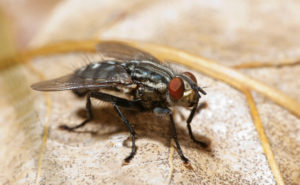
Flesh flies are up to three times larger than house flies, and are grayish in color. PHOTO: COURTESY OF, AND COPYRIGHTED BY, GENE WHITE, PMIMAGES@EARTHLINK.NET
Family: Sarcophagidae
Flesh flies often are numerous in populated areas, but seldom enter houses or food-handling establishments in significant numbers. Females of many species lay living larvae on meat scraps, decayed flesh or dog excrement. Adult flies frequently are annoying outdoors near dog runs.
Adult flesh flies have a gray-and-black checkerboard pattern on their abdomen and three dark longitudinal stripes on the thorax.
Orkin Pest Control offers these six components of a flesh fly integrated pest management (IPM) plan:
- Identification: Because not all flies have the same behavior and habitat, it is important to correctly identify the offending insect so an effective and efficient IPM program can be put into place.
- Inspection: As with any pest, a thorough inspection will provide the information and observations needed to develop the proper IPM plan.
- Sanitation: Make recommendations to keep the property clean and get rid of all sources that provide flesh flies a suitable development habitat, such as pet feces in the yard or poorly maintained trash and compost bins.
- Exclusion: Seal and repair screens, holes, gaps, and any other entryways flesh flies may use to enter the structure.
- Traps: Illuminate traps to attract and capture flies.
- Insecticides: As needed, use appropriately labeled bait, aerosol or other professional pest control products to treat fly resting places.
Source: Truman’s Scientific Guide to Pest Management Operations, Seventh Edition, p. 340. The Guide is available for purchase at MyPMP.net/shop. The PMP staff also thanks Orkin Pest Control for sharing its expertise.
Leave A Comment